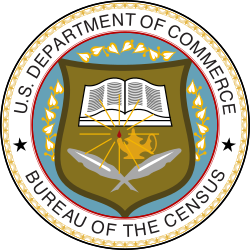1950 United States census Last updated October 11, 2025
17th US national census
Seventeenth census U.S. Census Bureau seal
1950 U.S. census logo
Country United States Total population 151,325,798 ( Most New York Least Nevada
The 1950 United States census , conducted by the Census Bureau , determined the resident population of the United States to be 151,325,798, an increase of 14.5 percent over the 131,669,275 persons enumerated during the 1940 census . [ 1]
This was the first census in which:
More than one state recorded a population of over 10 million Every state and territory recorded a population of over 100,000 All 100 largest cities recorded populations of over 100,000 On April 1, 2022, the National Archives and Records Administration released scanned census enumeration sheets to the general public, in accordance with the 72 year rule. [ 2] It is the most recent census to have full public availability.
Census questions The 1950 census collected the following information from all respondents: [ 3]
address whether house is on a farm name relationship to head of household race sex age marital status birthplace if foreign born, whether naturalized employment status hours worked in week occupation, industry and class of worker In addition, a sample of individuals were asked additional questions covering income, marital history, fertility, and other topics. Full documentation on the 1950 census, including census forms and a procedural history, is available from the Integrated Public Use Microdata Series .
State rankings A map showing the population change of each US State by percentage.
Rank State Population as of Population as of Change Percent 1 New York 14,830,192 13,479,142 1,351,050 10.0% 2 California 10,586,223 6,907,387 3,678,836 53.3% 3 Pennsylvania 10,498,012 9,900,180 597,832 6.0% 4 Illinois 8,712,176 7,897,241 814,935 10.3% 5 Ohio 7,946,627 6,907,612 1,039,015 15.0% 6 Texas 7,711,194 6,414,824 1,296,370 20.2% 7 Michigan 6,371,766 5,256,106 1,115,660 21.2% 8 New Jersey 4,835,329 4,160,165 675,164 16.2% 9 Massachusetts 4,690,514 4,316,721 373,793 8.7% 10 North Carolina 4,061,929 3,571,623 490,306 13.7% 11 Missouri 3,954,653 3,784,664 169,989 4.5% 12 Indiana 3,934,224 3,427,796 506,428 14.8% 13 Georgia 3,444,578 3,123,723 320,855 10.3% 14 Wisconsin 3,434,575 3,137,587 296,988 9.5% 15 Virginia 3,318,680 2,677,773 640,907 23.9% 16 Tennessee 3,291,718 2,915,841 375,877 12.9% 17 Alabama 3,061,743 2,832,961 228,782 8.1% 18 Minnesota 2,982,483 2,792,300 190,183 6.8% 19 Kentucky 2,944,806 2,845,627 99,179 3.5% 20 Florida 2,771,305 1,897,414 873,891 46.1% 21 Louisiana 2,683,516 2,363,516 320,000 13.5% 22 Iowa 2,621,073 2,538,268 82,805 3.3% 23 Washington 2,378,963 1,736,191 642,772 37.0% 24 Maryland 2,343,001 1,821,244 521,757 28.6% 25 Oklahoma 2,233,351 2,336,434 −103,083 −4.4% 26 Mississippi 2,178,914 2,183,796 −4,882 −0.2% 27 South Carolina 2,117,027 1,899,804 217,223 11.4% 28 Connecticut 2,007,280 1,709,242 298,038 17.4% 29 West Virginia 2,005,552 1,901,974 103,578 5.4% 30 Arkansas 1,909,511 1,949,387 −39,876 −2.0% 31 Kansas 1,905,299 1,801,028 104,271 5.8% 32 Oregon 1,521,341 1,089,684 431,657 39.6% 33 Nebraska 1,325,510 1,315,834 9,676 0.7% 34 Colorado 1,325,089 1,123,296 201,793 18.0% 35 Maine 913,774 847,226 66,548 7.9% — District of Columbia 802,178 663,091 139,087 21.0% 36 Rhode Island 791,896 713,346 78,550 11.0% 37 Arizona 749,587 499,261 250,326 50.1% 38 Utah 688,862 550,310 138,552 25.2% 39 New Mexico 681,187 531,818 149,369 28.1% 40 South Dakota 652,740 642,961 9,779 1.5% 41 North Dakota 619,636 641,935 −22,299 −3.5% 42 Montana 591,024 559,456 31,568 5.6% 43 Idaho 588,637 524,873 63,764 12.1% 44 New Hampshire 533,242 491,524 41,718 8.5% — Hawaii 499,794 422,770 77,024 18.2% 45 Vermont 377,747 359,231 18,516 5.2% 46 Delaware 318,085 266,505 51,580 19.4% 47 Wyoming 290,529 250,742 39,787 15.9% 48 Nevada 160,083 110,247 49,836 45.2% — Alaska 128,643 72,524 56,119 77.4% — United States 151,325,798 132,164,569 19,161,229 14.5%
City rankings Rank City State Population [ 6] Region (2016) [ 7] 01 New York New York 7,891,957 Northeast 02 Chicago Illinois 3,620,962 Midwest 03 Philadelphia Pennsylvania 2,071,605 Northeast 04 Los Angeles California 1,970,358 West 05 Detroit Michigan 1,849,568 Midwest 06 Baltimore Maryland 949,708 South 07 Cleveland Ohio 914,808 Midwest 08 St. Louis Missouri 856,796 Midwest 09 Washington District of Columbia 802,178 South 10 Boston Massachusetts 801,444 Northeast 11 San Francisco California 775,357 West 12 Pittsburgh Pennsylvania 676,806 Northeast 13 Milwaukee Wisconsin 637,392 Midwest 14 Houston Texas 596,163 South 15 Buffalo New York 580,132 Northeast 16 New Orleans Louisiana 570,445 South 17 Minneapolis Minnesota 521,718 Midwest 18 Cincinnati Ohio 503,998 Midwest 19 Seattle Washington 467,591 West 20 Kansas City Missouri 456,622 Midwest 21 Newark New Jersey 438,776 Northeast 22 Dallas Texas 434,462 South 23 Indianapolis Indiana 427,173 Midwest 24 Denver Colorado 415,786 West 25 San Antonio Texas 408,442 South 26 Memphis Tennessee 396,000 South 27 Oakland California 384,575 West 28 Columbus Ohio 375,901 Midwest 29 Portland Oregon 373,628 West 30 Louisville Kentucky 369,129 South 31 San Diego California 334,387 West 32 Rochester New York 332,488 Northeast 33 Atlanta Georgia 331,314 South 34 Birmingham Alabama 326,037 South 35 Saint Paul Minnesota 311,349 Midwest 36 Toledo Ohio 303,616 Midwest 37 Jersey City New Jersey 299,017 Northeast 38 Fort Worth Texas 278,778 South 39 Akron Ohio 274,605 Midwest 40 Omaha Nebraska 251,117 Midwest 41 Long Beach California 250,767 West 42 Miami Florida 249,276 South 43 Providence Rhode Island 248,674 Northeast 44 Dayton Ohio 243,872 Midwest 45 Oklahoma City Oklahoma 243,504 South 46 Richmond Virginia 230,310 South 47 Syracuse New York 220,583 Northeast 48 Norfolk Virginia 213,513 South 49 Jacksonville Florida 204,517 South 50 Worcester Massachusetts 203,486 Northeast 51 Tulsa Oklahoma 182,740 South 52 Salt Lake City Utah 182,121 West 53 Des Moines Iowa 177,965 Midwest 54 Hartford Connecticut 177,397 Northeast 55 Grand Rapids Michigan 176,515 Midwest 56 Nashville Tennessee 174,307 South 57 Youngstown Ohio 168,330 Midwest 58 Wichita Kansas 168,279 Midwest 59 New Haven Connecticut 164,443 Northeast 60 Flint Michigan 163,143 Midwest 61 Springfield Massachusetts 162,399 Northeast 62 Spokane Washington 161,721 West 63 Bridgeport Connecticut 158,709 Northeast 64 Yonkers New York 152,798 Northeast 65 Tacoma Washington 143,673 West 66 Paterson New Jersey 139,336 Northeast 67 Sacramento California 137,572 West 68 Arlington Virginia 135,449 South 69 Albany New York 134,995 Northeast 70 Charlotte North Carolina 134,042 South 71 Gary Indiana 133,911 Midwest 72 Fort Wayne Indiana 133,607 Midwest 73 Austin Texas 132,459 South 74 Chattanooga Tennessee 131,041 South 75 Erie Pennsylvania 130,803 Northeast 76 El Paso Texas 130,485 South 77 Kansas City Kansas 129,553 Midwest 78 Mobile Alabama 129,009 South 79 Evansville Indiana 128,636 Midwest 80 Trenton New Jersey 128,009 Northeast 81 Shreveport Louisiana 127,206 South 82 Baton Rouge Louisiana 125,629 South 83 Scranton Pennsylvania 125,536 Northeast 84 Knoxville Tennessee 124,769 South 85 Tampa Florida 124,681 South 86 Camden New Jersey 124,555 Northeast 87 Cambridge Massachusetts 120,740 Northeast 88 Savannah Georgia 119,638 South 89 Canton Ohio 116,912 Midwest 90 South Bend Indiana 115,911 Midwest 91 Berkeley California 113,805 West 92 Elizabeth New Jersey 112,817 Northeast 93 Fall River Massachusetts 111,963 Northeast 94 Peoria Illinois 111,856 Midwest 95 Wilmington Delaware 110,356 South 96 Reading Pennsylvania 109,320 Northeast 97 New Bedford Massachusetts 109,189 Northeast 98 Corpus Christi Texas 108,287 South 99 Phoenix Arizona 106,818 West 100 Allentown Pennsylvania 106,756 Northeast
Locations of 50 most populous cities Location of 50 largest cities by population in the United States in 1950
References ↑ "Population and Area (Historical Censuses)" (PDF) . United States Census Bureau. Archived (PDF) from the original on June 24, 2008. Retrieved June 20, 2008 . 1 2 "1950 Census on Track for 2022 Release, Despite Pandemic" . National Archives and Records Administration. April 30, 2021. Retrieved January 13, 2022 . ↑ "Library Bibliography Bulletin 88, New York State Census Records, 1790–1925" . New York State Library . October 1981. p. 45. Retrieved December 15, 2008 . ↑ "The "72-Year Rule" – History" . United States Census Bureau. Retrieved October 26, 2015 . ↑ "Free 1950 Census Search" . Historic Journals LLC. Retrieved March 31, 2022 . ↑ Population of the 100 Largest Cities and Other Urban Places in the United States: 1790 to 1990 ↑ "Regions and Divisions" . United States Census Bureau. Archived from the original on December 3, 2016. Retrieved September 9, 2016 . This page is based on this
Wikipedia article Text is available under the
CC BY-SA 4.0 license; additional terms may apply.
Images, videos and audio are available under their respective licenses.




